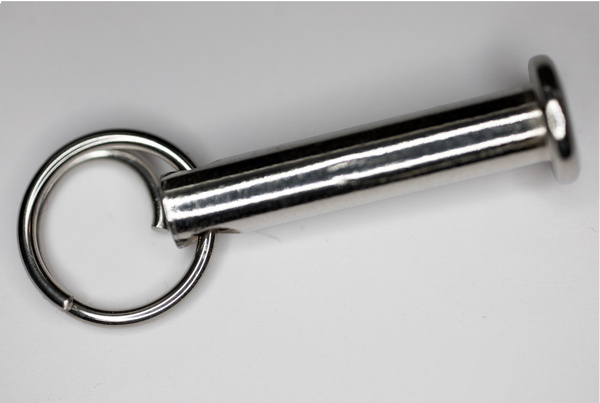Have you ever wondered how your favorite garment’s intricate patterns and precise stitching are achieved? A key component behind these flawless creations is the reliable performance of garment manufacturing equipment. While these machines are engineering marvels, their smooth operation often hinges on seemingly insignificant parts: clevis pins.

With that in mind, this article will explore its significance in garment manufacturing equipment, provide insights into its maintenance and selection, and offer practical tips to optimize its performance and ensure uninterrupted production.
1. Joining Movable Parts
Clevis pins are crucial in connecting movable parts of garment manufacturing machinery. These machines often contain arms, rods, or other components that need to pivot or move smoothly to perform functions like sewing, cutting, or stretching fabric. Clevis pins act as the joint that holds these parts together while allowing them to rotate or slide as necessary.
Because of their removable nature, a clevis pin makes it easy to maintain or adjust these parts without requiring permanent fixation or complicated disassembly. To ensure the correct pin size is used for optimal performance, it’s crucial to refer to a detailed sizing guide. Download clevis pin size chart for a comprehensive overview of available dimensions to match the needs of your machinery.
2. Fastening and Securing Components
In addition to facilitating movement, clevis pins are also used to fasten components that must remain securely in place during machine operation. Garment manufacturing equipment often has parts that need to be locked into position, such as guide rods or brackets, which ensure the precise handling and positioning of fabric. A clevis pin offer a reliable solution for securing these elements.
Furthermore, their design allows for a secure fit while remaining easy to remove when adjustments or maintenance are required. This ease of fastening and unfastening is critical in a manufacturing environment, where the machinery must run consistently, and downtime for repairs or adjustments must be minimized. A clevis pin can hold parts securely, ensuring the machine functions accurately and efficiently.
3. Allowing Adjustable Parts
Garment manufacturing often involves working with a wide range of fabrics, garment sizes, and designs, necessitating frequent machinery adjustments. Clevis pins facilitate these adjustments by allowing for the easy repositioning of machine parts. For instance, in fabric cutting machines or sewing tables, clevis pins may be used to modify the height or angle of a cutting blade or a fabric guide.
This adaptability is crucial for ensuring the machine can accommodate various production requirements without complex tools or disassembly. Clevis pins allow you to fine-tune the settings quickly, which increases flexibility in production and ensures that manufacturers can switch between different garment types or sizes without wasting valuable time.
4. Durability and Strength
Garment manufacturing machinery must endure the repetitive stresses and pressures of high-speed production. Clevis pins, often made from durable materials like stainless steel or heavy-duty alloys, provide the strength to withstand these conditions. Whether holding together pivotal machine parts or securing components under pressure, clevis pins maintain their structural integrity even after extended use.
Moreover, this durability ensures that the machinery operates reliably over time, reducing the likelihood of unexpected failures that could disrupt production. For garment manufacturers, the robustness of a clevis pin translates into longer machine lifespans and decreasing costs associated with frequent repairs or replacements. Their strength allows machines to function at their best, even under continuous operation.
5. Ease of Maintenance
Maintenance is essential for keeping garment manufacturing equipment in optimal condition. Clevis pins contribute to easier and faster maintenance by being straightforward to remove and replace. This feature is particularly beneficial for machines that require frequent cleaning or servicing, such as those that deal with fabrics, threads, and oils, which can build up in mechanical parts over time.
With a clevis pin, maintenance staff can quickly disassemble the necessary sections of the machine without taking apart the entire system, saving valuable time. Additionally, their design means that once maintenance is completed, the pins can be easily reinserted, ensuring the machine is back in operation with minimal downtime.
6. Alignment Purposes
Precision is paramount in garment manufacturing, where even slight misalignments can result in defects in the finished product. Clevis pins are instrumental in properly aligning moving parts within the machinery. Whether aligning the feed mechanisms in a sewing machine or ensuring the straightness of fabric cutters, clevis pins help keep parts in the correct position.
This precision ensures that fabric is fed smoothly, seams are straight, and cuts are accurate, all of which contribute to the overall quality of the garment. By holding parts securely in alignment, clevis pins help minimize production errors, ensure consistent output, and reduce waste. Their role in alignment is vital for maintaining the high standards required in garment manufacturing.
Conclusion
While often overlooked, clevis pins are indispensable components in garment manufacturing equipment. By understanding their significance, garment manufacturers can optimize their production processes, reduce downtime, and ultimately achieve greater success in the competitive fashion industry.

Mayedul Islam is a Founder and Editor of Garments Merchandising. He is an Expert in Garments Merchandising. Writing is his passion. He loves to write articles about Apparel, Textile and Garment Washing specially on Merchandising. Mail him at mayedul.islam66@gmail.com

